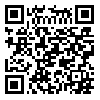Volume 65, Issue 4 (3 2007)
Tehran Univ Med J 2007, 65(4): 65-71 |
Back to browse issues page
Download citation:
BibTeX | RIS | EndNote | Medlars | ProCite | Reference Manager | RefWorks
Send citation to:



BibTeX | RIS | EndNote | Medlars | ProCite | Reference Manager | RefWorks
Send citation to:
Niroomand N, Davari Tanha F, Kaveh M. The effect of twin discordancy on pregnancy outcome. Tehran Univ Med J 2007; 65 (4) :65-71
URL: http://tumj.tums.ac.ir/article-1-805-en.html
URL: http://tumj.tums.ac.ir/article-1-805-en.html
Abstract: (5745 Views)
Background: The aim of this survey was to evaluate the prevalence of some perinatal complications in birth weight discordance (BWD) among twin pregnancies.
Methods: In a descriptive analytical cross-sectional study, 490 twin neonates (245 twin pregnancies) born at Mirzakoochakkhan Hospital from 1999 to 2003 were evaluated. Maternal and neonatal data of each delivery were collected for BWD, gestational age, maternal age, parity, infant gender, neonatal death, neonatal septicemia, mode of delivery, hyperbilirubinemia, blood transfusion and duration of hospitalization.
Results: The average age of the mothers was 26±4.78 years, of which 51.8% were nullipara. The average gestational age was 35.02±2.73 weeks, with 15.9% before 32 weeks of gestation. The neonatal death rate was 7.8%, the majority of which involved male neonates and multiparas. The average duration of hospitalization was 6.07±4.45 days, 8.5 days for those twins with BWD≥20%, and longer (9.14 days) for neonates with mothers younger than 20 years old. Septicemia was most frequent (31.3%) in twins with BWD of 30-34%, as was hyperbilirubinemia requiring blood transfusion (25%). Hyperbilirubinemia was more common in neonates with mothers aged less than 20 years and more than 35 years..
Conclusions: BWD in twins is a predictive factor for septicemia and hyperbilirubinemia requiring transfusion. Therefore, healthcare workers and hospital wards dealing with twins with BWD should be especially ready and equipped to provide the additional care needed for these patients.
Methods: In a descriptive analytical cross-sectional study, 490 twin neonates (245 twin pregnancies) born at Mirzakoochakkhan Hospital from 1999 to 2003 were evaluated. Maternal and neonatal data of each delivery were collected for BWD, gestational age, maternal age, parity, infant gender, neonatal death, neonatal septicemia, mode of delivery, hyperbilirubinemia, blood transfusion and duration of hospitalization.
Results: The average age of the mothers was 26±4.78 years, of which 51.8% were nullipara. The average gestational age was 35.02±2.73 weeks, with 15.9% before 32 weeks of gestation. The neonatal death rate was 7.8%, the majority of which involved male neonates and multiparas. The average duration of hospitalization was 6.07±4.45 days, 8.5 days for those twins with BWD≥20%, and longer (9.14 days) for neonates with mothers younger than 20 years old. Septicemia was most frequent (31.3%) in twins with BWD of 30-34%, as was hyperbilirubinemia requiring blood transfusion (25%). Hyperbilirubinemia was more common in neonates with mothers aged less than 20 years and more than 35 years..
Conclusions: BWD in twins is a predictive factor for septicemia and hyperbilirubinemia requiring transfusion. Therefore, healthcare workers and hospital wards dealing with twins with BWD should be especially ready and equipped to provide the additional care needed for these patients.
| Rights and permissions | |
 |
This work is licensed under a Creative Commons Attribution-NonCommercial 4.0 International License. |





